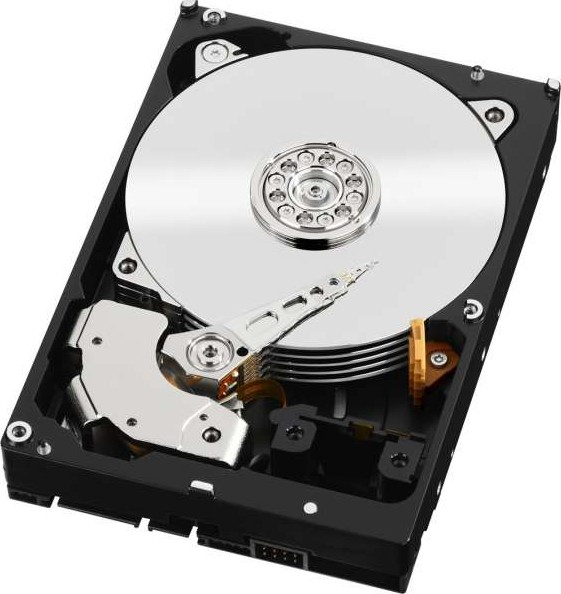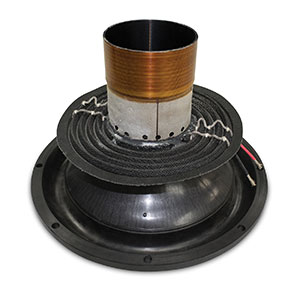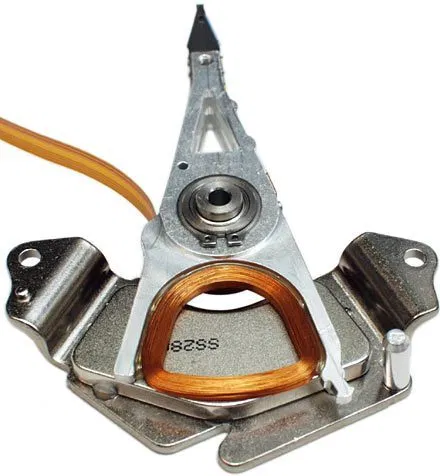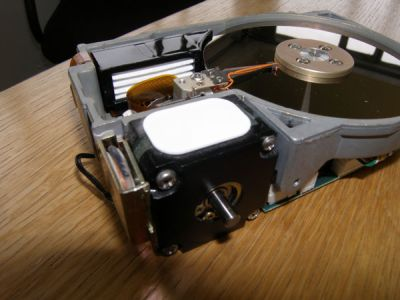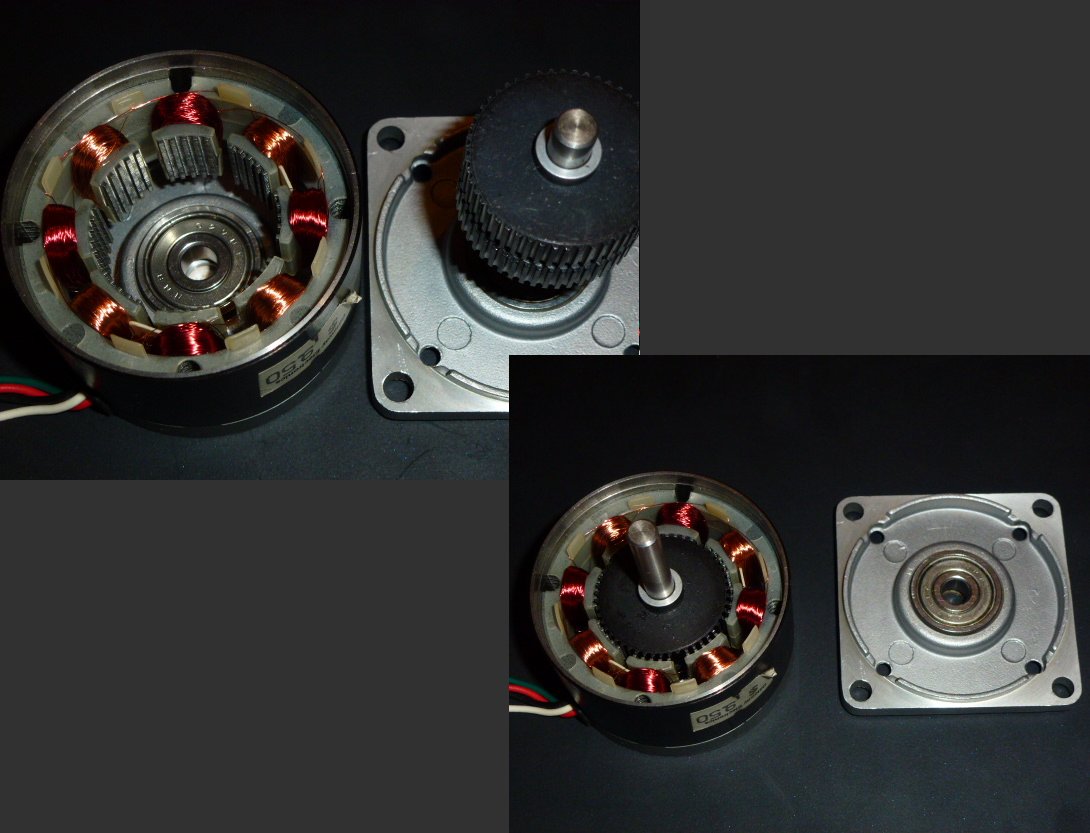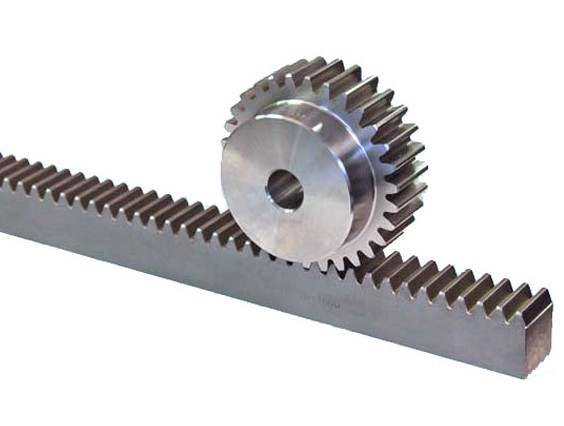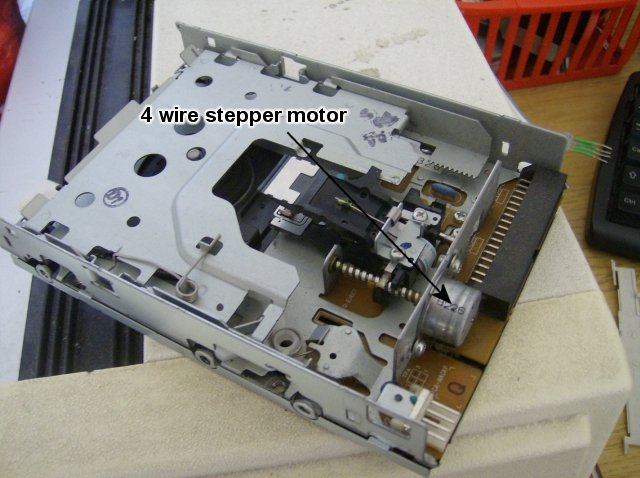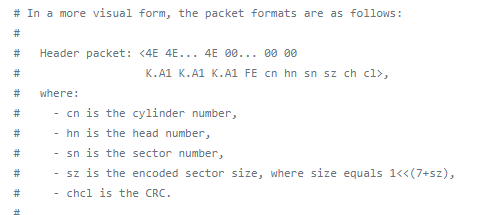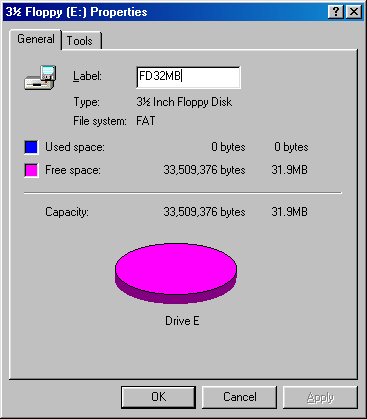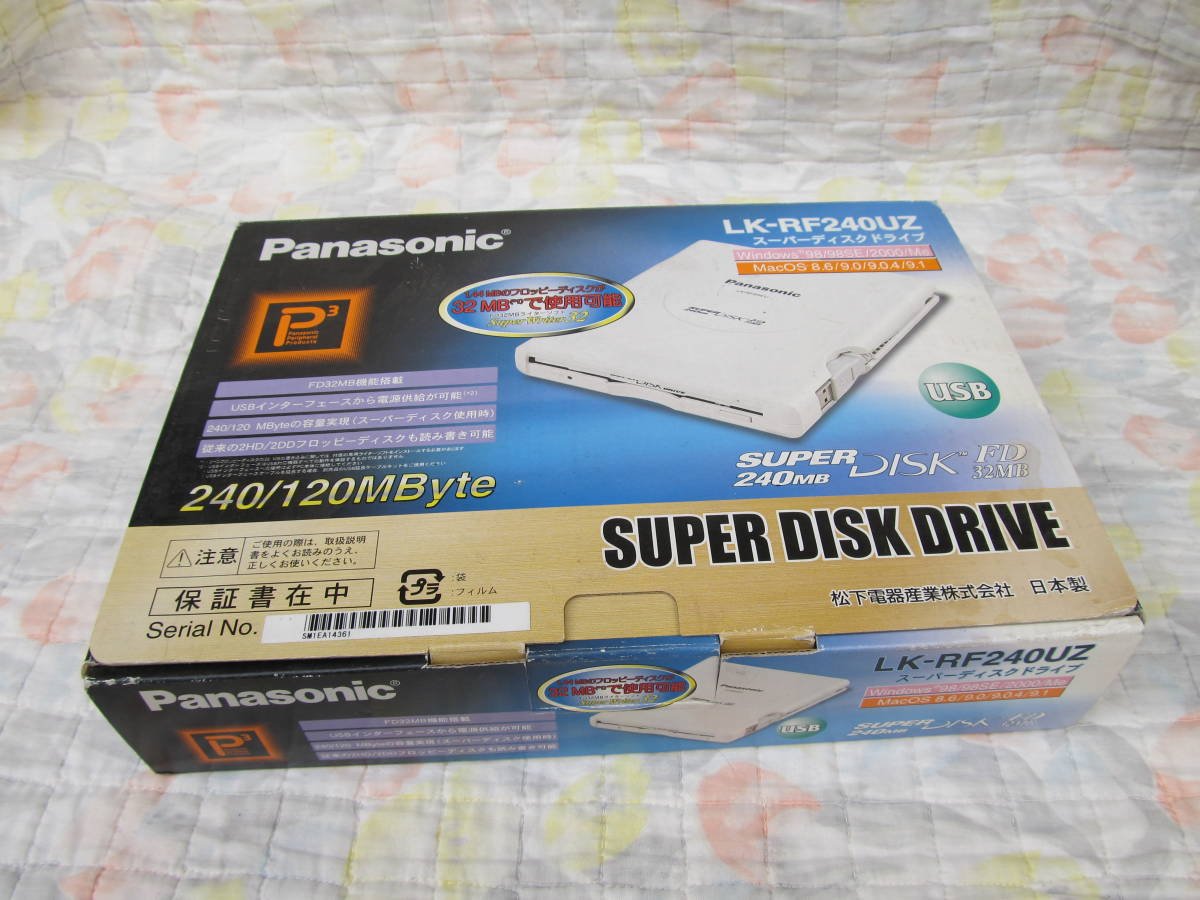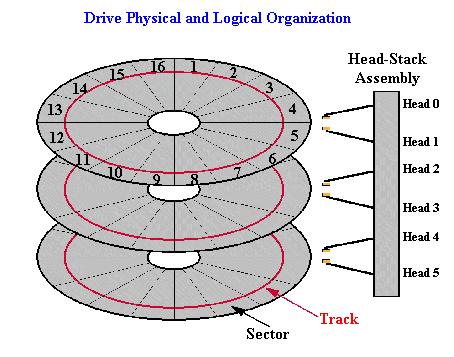Ever wonder how superfloppy drives like the zip drive and LS-120 (shown here) are able to stuff so much data in the same form factor as a 1.44mb disk?
Here& #39;s inside of one, and you can see the trick on the right side. See those big pieces of metal? They& #39;re a voice coil.
Here& #39;s inside of one, and you can see the trick on the right side. See those big pieces of metal? They& #39;re a voice coil.
Here& #39;s a hard drive. In the bottom-left you& #39;ve got a voice coil, too. Voice coils are very important to how hard drives work (at least for the last 30 years or so...)
So voice coils are called that because their primary use is in speakers. They& #39;re a coil of wire around a magnet, and by changing the current going through the coil, you move the magnet back and forth
which is used in speakers by making the current match the amplitude of the sound being played, so the speaker moves back and forth to match it, replicating the sound.
So the voice coil in a hard drive (and this LS-120) drive puts the coiled wires inside the magnets. With no current flowing through, the coil will rest at one end, and with maximum current, it& #39;ll be at the other end.
but importantly, it& #39;s an analog device: you can accurately position it at any point in between those two ends by controlling the amount of current going through.
So the magnetic surface of the drive will have some precisely-written low level formatting marks on it that say "here& #39;s where track 1 is" then "here& #39;s where track 10 is" and so on for tons of tracks
and when the drive spins up when you power the PC on, it finds those tracks by slowly increasing the power, until it has found them all and it can now record what current levels take it to what tracks, for fast seeking later.
FUN FACT: for a very long time hard drives have required this low-level formatting to be done with more accurate equipment than is in the drive itself, which is done at manufacturing time.
So once it leaves the factor, it can& #39;t be low-level formatted again.
So once it leaves the factor, it can& #39;t be low-level formatted again.
which means if you do manage to erase a hard drive with a very strong magnet, you will destroy this low level formatting, and the drive is now bricked.
Stepper motors work differently from normal full-rotation motors, where they have a bunch of distinct coils which can be controlled separately. A normal motor will spin up the axle and keep it at that speed... stepper motors move in (GUESS WHAT) steps.
The idea is that by controlling the coils separately, you can turn the axle in small, precise rotations.
You hook that up to a rack-and-pinion system and now you can move the head in and out.
So you set it up so that you have the first track at one end of the rack, and each step moves you to the next track. Simple! Reliable! Easy! But it& #39;s coarse.
So you set it up so that you have the first track at one end of the rack, and each step moves you to the next track. Simple! Reliable! Easy! But it& #39;s coarse.
The size of your tracks is determined by your gearing and your motor, so you can& #39;t just invent a new material for the magnetic surface and stuff more tracks into it by making tracks smaller. You have to change your mechanical parts too.
Whereas with a voice coil, you just need to make sure your actuator control mechanism has enough resolution to produce the exact currents you& #39;d need to hit tracks that small.
So a voice coil system makes it possible to put the tracks closer together (in combination with better materials that can actually handle tracks that close together) and can be upgraded with less re-engineering effort.
Your floppy disk is only going go have like 30-80 tracks, so you just need to be able to hit those tracks, and the cheapest and easiest way to do that is a stepper motor.
But using the stepper motor limits how precisely the tracks can be laid down, which means you can& #39;t go much past those track numbers, even if you do switch to a higher-quality magnetic media that can handle them.
So to get the much larger storage capacities in (roughly) the same physical size, drives like the LS-120 and Zip Drive switch to a voice coil and have far more tracks per inch than a standard HD floppy disk
Your standard HD 3.5" disk has 135 tracks per inch.
LS-120 disks cram in 2,490 tracks per inch.
LS-120 disks cram in 2,490 tracks per inch.
This also means they need to have servo tracks for the voice coil to calibrate against... which means they can be bricked by externally wiping them. If you use a degaussing coil on a LS-120 or zip disk to wipe them? You& #39;ll wipe them, sure, but now the disk is useless forever.
There& #39;s an interesting complication of this design for LS-120 drives that zip drives don& #39;t have:
LS-120 drives can read standard HD disks.
How?
LS-120 drives can read standard HD disks.
How?
LS-120 drives have no stepper motor for accurately seeking to a track, and HD disks have no servo tracks for them to calibrate against, so they shouldn& #39;t be able to easily seek to a given track.
I don& #39;t have an official explanation of how they do this but I think I can guess from watching one read an entire HD disk...
Watch how the head moves here as it& #39;s reading the whole disk, beginning to end:
Watch how the head moves here as it& #39;s reading the whole disk, beginning to end:
it doesn& #39;t just start and one end and slowly increase to the other end. Instead it keeps seeking to a point and then seeking backwards, then seeking forward again.
I think it& #39;s trying to read the track at multiple different positions, while measuring the signal coming back
I think it& #39;s trying to read the track at multiple different positions, while measuring the signal coming back
so it sort of slides across the track until it hits the right position to get the whole thing.
It also does a lot of initial seeking when you first put in a disk, which means it takes much longer to start up with a new floppy then a standard drive.
It also does a lot of initial seeking when you first put in a disk, which means it takes much longer to start up with a new floppy then a standard drive.
I bet during that time it& #39;s reading all over the disk to figure out where the tracks are, so it can then roughly calibrate against them later.
IBM PC sectors have their cylinder (track, basically)/head/sector-number encoded into their header, so by reading random sectors you can figure out where the tracks are.
in theory, at least.
If you& #39;re using a weird disk which is playing tricksy games with the sector headers (for copy protection reasons, for example) it might not work. But I figure they& #39;re not worried too much about the LS-120 having compatibility with those.
If you& #39;re using a weird disk which is playing tricksy games with the sector headers (for copy protection reasons, for example) it might not work. But I figure they& #39;re not worried too much about the LS-120 having compatibility with those.
ANYWAY: the tl;dr is that superfloppies store more on the same-size of media by using a voice coil to more precisely read and write tracks, so those tracks can be smaller and therefore more can be packed onto the disk
final fun fact: the rare LS-240 drive had a neat trick it could do.
So different magnetic material is an important part of being able to fit more tracks on a disk... but it& #39;s not all of it.
If you have a voice coil, you could put more data onto a standard 3.5" HD disk, in theory
So different magnetic material is an important part of being able to fit more tracks on a disk... but it& #39;s not all of it.
If you have a voice coil, you could put more data onto a standard 3.5" HD disk, in theory
and the LS-240 could do it.
It was called FD32MB mode, and it managed to stuff 32 megabytes onto a bog-standard high density 3.5" disk!
It was called FD32MB mode, and it managed to stuff 32 megabytes onto a bog-standard high density 3.5" disk!
It did this by formatting part of the disk as a standard HD disk, with a bunch of sectors marked as bad and a text file saying "HEY THIS SHOULD ONLY BE USED IN A LS-240 DRIVE", then the rest of it was a bunch of carefully positioned tiny tracks
The big limitation this had was that it couldn& #39;t reliably seek to those tracks for rewriting them, so instead you had to rewrite the entire drive every time you wanted to change anything, kinda like a CD-RW in disc-at-once mode.
So this wasn& #39;t super useful (and I can& #39;t imagine it was that reliable, but this was so obscure a feature I haven& #39;t seen anyone test it) but it was a very neat trick.
THe LS-120 wasn& #39;t very popular in most of the world (although it was relatively more popular in Japan) so the LS-240 only really came out in Australia and Japan, in 2000.
By then everyone was going for CD-burners, which had greater compatibility (since basically everyone had a CD-ROM drive by then) and prices were rapidly shrinking, and storage was much greater (640mb vs 240mb), and USB flash drives were developed soon afterwards
so LS240 never really caught on, but still... it& #39;s totally cool.
OK CORRECTION: I& #39;m misinformed about how the LS120 works on a LS-120 disk: Unlike zip disks and hard disks, it doesn& #39;t use magnetic servo tracks: it uses optical servo tracks.
this means it& #39;s a floptical disk, where it uses magnetically recorded media with optical positioning.
In the case of the LS-120/240, it& #39;s a laser that is used to detect special tracks on the surface of the disk, which were put down during manufacturing
In the case of the LS-120/240, it& #39;s a laser that is used to detect special tracks on the surface of the disk, which were put down during manufacturing
presumably it& #39;s either an opacity change or a reflectivity change, but I& #39;m not sure which.
And this has the benefit that these disks don& #39;t get bricked by external erasing, since they don& #39;t get erased by the process.
And this has the benefit that these disks don& #39;t get bricked by external erasing, since they don& #39;t get erased by the process.
thanks to @VXO for the correction!
anyway, random tangent about low-level formatting:
back when you could still do that on hard drives, one of the reasons you could was because you might HAVE to, because how the drive was formatted depended on how fast your computer was!
back when you could still do that on hard drives, one of the reasons you could was because you might HAVE to, because how the drive was formatted depended on how fast your computer was!
and the reason was something called SECTOR INTERLEAVE.
The general diagram for how tracks on a harddrive works always shows the sectors in simple increasing order, 1/2/3/4/5/6/7...
The general diagram for how tracks on a harddrive works always shows the sectors in simple increasing order, 1/2/3/4/5/6/7...
but hang on, while the computer is on, the hard drive is spinning... (since we didn& #39;t have power management to shut it off at this point)
So the head is moving no matter what the computer is doing or how long it takes to do it.
So the head is moving no matter what the computer is doing or how long it takes to do it.
and imagine what happens if you need to read a lot of data (like 8 sectors, 4 entire kilobytes) at once.
So the drive seeks to the right track, it starts reading until it finds sector 1, and starts reading..., then decodes and processes it.
So the drive seeks to the right track, it starts reading until it finds sector 1, and starts reading..., then decodes and processes it.
now it& #39;s ready to read sector 2. ok, now we need to read sector 2! except... while we were processing sector 1, the drive was still spinning. So what& #39;s under the drive head now? sector 3!
so we gotta wait for the platter to finish spinning around until sector 2 shows up again.
so we gotta wait for the platter to finish spinning around until sector 2 shows up again.
we get sector 2, process it, and we& #39;re ready for sector 3... except now sector 4 is under the head. This is basically the slowest it can be: we have to do a full rotation for every sector. That sucks.
SO, what if instead of writing the sectors down as sectors:
1/2/3/4/5/6
we wrote them down as:
1/4/2/5/3/6
?
1/2/3/4/5/6
we wrote them down as:
1/4/2/5/3/6
?
We still can read and write in "order", there& #39;s just a different sector that goes by while we& #39;re processing. Since we don& #39;t have the speed to read that sector anyway, who cares that we miss it?
and it means that if we are trying to read a bunch of sectors in order, they just naturally show up as we need them! perfect!
but this is a low-level formatting thing.
Since low level formatting is putting down the sectors and sector headers, and high level formatting is putting the bytes in those sectors and the filesystem inside them.
Since low level formatting is putting down the sectors and sector headers, and high level formatting is putting the bytes in those sectors and the filesystem inside them.
So if we want to rearrange the sectors, we have to low-level format the drive.
And the company making the drive has no idea if you have a computer fast enough to not need sector interleaving, or if you do... and if you do need it, how much?
And the company making the drive has no idea if you have a computer fast enough to not need sector interleaving, or if you do... and if you do need it, how much?
because maybe it doesn& #39;t just take 1-sectors-worth-of-spin-time to process a sector, maybe it takes 2, or 3?
so you need even more sector interleave to make this work.
so you need even more sector interleave to make this work.
So yeah...
on old hard drives that could do low level formatting, one of the reasons they could do it was because you could optimize the speed of your drive by adjusting your sector interleave.
on old hard drives that could do low level formatting, one of the reasons they could do it was because you could optimize the speed of your drive by adjusting your sector interleave.
too little sector interleave, and your drive will be slow because it has to spin all the way around to find the sector it wants.
too much and it& #39;ll be slow because it has to wait longer for sectors to show up
too much and it& #39;ll be slow because it has to wait longer for sectors to show up
one of the ways later drives (without the ability to low-level format them) avoid the problem of incorrect interleave is by having a drive cache. so when you ask for sector 4, it reads it and also reads sector 5 and 6 and 7...

 Read on Twitter
Read on Twitter